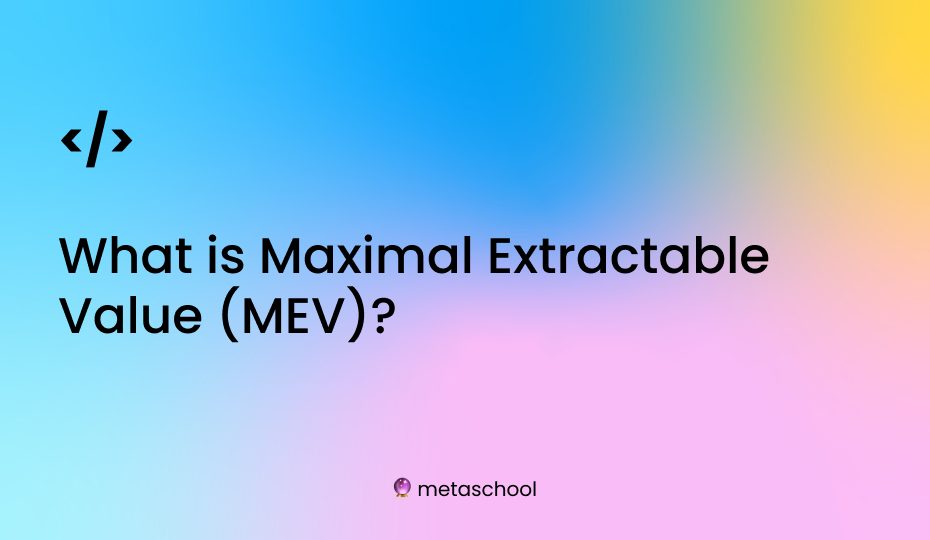Table of Contents
Maximal Extractable Value or MEV in crypto refers to the maximum profit that can be extracted from a transaction on a blockchain network. It is a measure of the potential profit that can be gained by executing a transaction at a specific time and in a specific manner.
What is MEV?
MEV is commonly used in the context of DeFi (decentralized finance) protocols, where it refers to the potential profit that can be gained by executing a transaction on a protocol at a specific time and in a specific manner. This can be done through arbitrage, front-running, or other strategies that take advantage of the potential profit opportunities on DeFi protocols.
MEV is a key concept in DeFi because it allows users to extract value from the network by executing transactions in a way that maximizes their potential profit. This can be done through a variety of strategies, such as identifying and executing arbitrage opportunities, front-running transactions, or other tactics that take advantage of the potential profit opportunities on DeFi protocols.
MEV is also a valuable tool for DeFi users because it allows them to extract maximum value from the network by executing transactions in a way that maximizes their potential profit. This can help users increase their returns, reduce their risk, and improve their overall performance on DeFi protocols.
How does MEV in crypto work?
MEV works by identifying and exploiting potential profit opportunities on blockchain networks. This is typically done through arbitrage, front-running, or other strategies that take advantage of the potential profit opportunities on blockchain networks.
To extract Maximal Extractable Value (MEV), users first need to identify potential profit opportunities on the network. This can be done through a variety of methods, such as analyzing the market for arbitrage opportunities, monitoring transaction fees, or using tools and algorithms to identify potential profit opportunities.
Once potential profit opportunities have been identified, users can then execute transactions on the network in a way that maximizes their potential profit. This can be done through a variety of strategies, such as front-running transactions, executing arbitrage trades, or using other tactics that take advantage of the potential profit opportunities on the network.
Tactics used in MEV
1) Arbitrage
Arbitrage is a tactic used to take advantage of price differences between different markets or exchanges. By buying an asset on one market and selling it on another market, users can profit from the price difference between the two markets. This is a common tactic used in MEV to extract value from the network by executing transactions in a way that maximizes potential profit.
2) Front-running
Front-running is a tactic used to execute transactions before other users in order to take advantage of potential profit opportunities. By executing transactions before other users, front-runners can profit from the potential profit opportunities on the network. This is a common tactic used to extract value from the network by executing transactions in a way that maximizes potential profit.
3) Liquidity mining
Liquidity mining is a tactic used to incentivize users to provide liquidity to decentralized finance (DeFi) protocols. By providing liquidity to DeFi protocols, users can earn rewards in the form of tokens or other assets. This is a common tactic used in MEV to extract value from the network by providing liquidity to DeFi protocols and earning rewards for doing so.
Benefits of MEV
There are some benefits to MEV, although they are controversial and not universally accepted.
One potential benefit of MEV is that it can lead to more efficient markets on blockchain networks. By taking advantage of potential profit opportunities on the network, MEV can help to allocate resources more efficiently and reduce market inefficiencies. This can lead to more efficient and fair markets on blockchain networks.
Another potential benefit of in crypto, of MEV, is that it can help to incentivize users to provide liquidity to decentralized finance (DeFi) protocols. By offering rewards to users who provide liquidity to DeFi protocols, MEV can help to increase liquidity and make the protocols more efficient and fair.
Additionally, MEV can help to improve the security and reliability of blockchain networks. By executing transactions in a way that maximizes potential profit, MEV can help to identify and exploit vulnerabilities on the network, which can help to improve the overall security and reliability of the network.
Overall, while there are some potential benefits to MEV, they are controversial and not universally accepted. Some argue that its benefits are outweighed by the potential drawbacks, such as unfair or unethical behavior, higher transaction fees and lower liquidity, and a concentration of wealth and power on blockchain networks.
The challenges with MEV
Maximal Extractable Value is considered a problem by some because it can lead to unfair or unethical behavior on blockchain networks. By taking advantage of potential profit opportunities on the network, it can lead to front-running, arbitrage, and other tactics mentioned above that can be seen as unfair or unethical.
Additionally in crypto, MEV can lead to higher transaction fees and lower liquidity on blockchain networks. By executing transactions in a way that maximizes potential profit, MEV can drive up transaction fees and reduce liquidity on the network. This can make it more difficult and expensive for other users to transact on the network, leading to a less fair and efficient network.
Furthermore, it can lead to a concentration of wealth and power on blockchain networks. By extracting maximum value from the network, it can lead to a concentration of wealth and power in the hands of a few users who are able to take advantage of potential profit opportunities on the network. This can lead to a less decentralized and less equitable network.
Overall, some consider it an issue because it can lead to unfair or unethical behavior, higher transaction fees and lower liquidity, and a concentration of wealth and power on blockchain networks.
